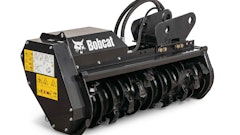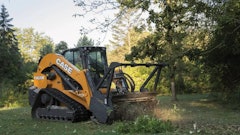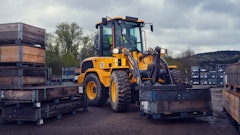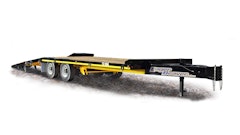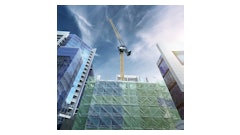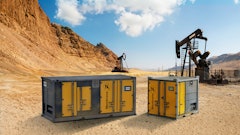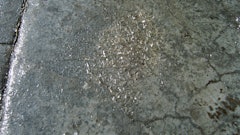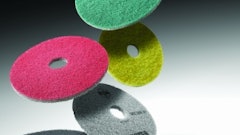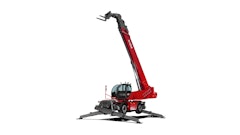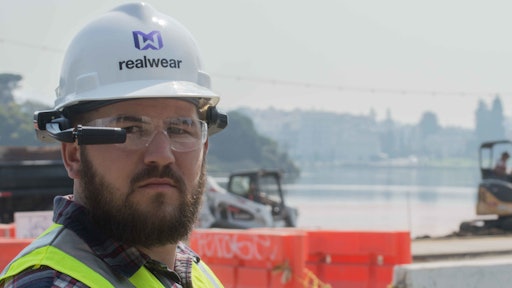
Wearable technologies (wearables) are increasing jobsite productivity and safety, and this is what is driving adoption of wearables on construction sites.
There are a lot of categories of wearables. “If you are defining a wearable in the broad sense, which is any technology that integrates your biology in some way, shape or form, the most popular uses are location and activity tracking, such as smart watches,” says James Benham, Founder & CEO of JBKnowledge and host of TheConTechCrew podcast. “You can broaden the category further to visual augmentation, such as the HoloLens, or even further to non-electronic, human, bio-mechanical technologies such as exoskeletons.”
“As with many technologies, there is some hesitation around adopting wearables. Some companies are quick to jump on board, but a lot of the construction industry is slow,” says Johnathan Fava, president, Scan-Link.
Read next: Reduce Construction Workplace Injuries with Wearable Technology“The main driver for wearables adoption is centered on worker safety,” says Ian Ouelette, vice president, product, Triax Technologies. “Regulations play a part; New York, for example, has higher safety standards than most other districts. As well, people want the data that comes from having eyes on the jobsite. For example, visibility into the work performed by subcontractors helps general contractors know whether they are on schedule as they progress throughout the project.”
“Construction companies want to run a safer jobsite. Safety hazards, issues and incidents cost construction companies and their insurers significant amounts of money; so that drives a lot of adoption,” says Benham.
Wearable data collection means improved jobsites
Wearables that provide data are increasing the fastest in adoption because data drives a lot of decisions on construction projects.
“The data gives you eyes; it gives you trends,” says Fava. “The ability to gather data and telematics is the greatest driver for wearables adoption. From wearables, you are able to get loads of data from the workers themselves. It’s your crystal ball.”
Wearables have the ability to track the location of a worker, as well as some vital health signs, which can be used to prevent injuries at work.
 The Triax Spot-r System alerts health and safety personnel to worker falls and cuts evacuation times by more than 70%.
The Triax Spot-r System alerts health and safety personnel to worker falls and cuts evacuation times by more than 70%.
“Tracking where a worker is, monitoring their life signs — their heart rate, their pulse, their galvanic skin response, which indicates a heat stroke — are all very useful tools in identifying worker health and safety,” says Benham. “If you are tracking a worker’s heart rate, it allows you to monitor a worker’s health, and you can see someone is having an issue so you can take measures to try to save their life.”
“Labor tracking sounds sort of ominous, but many of us who work in a big office must have a key card to access the building. That is a form of labor tracking,” says Harris. “It’s really about the data — not in a Big Brother sort of way, but in a way that allows people to optimize work by using the data. With all the different subcontractors, people are always walking on and off your jobsite. That is the nature of the job. Labor tracking automatically tracks who is on site.”
Scan-Link tracks who is on the job
With radio frequency identification (RFID), you could create a turn-style access control point that can read people’s badges and then limits access to people with badges. The RFID scanner can also read information encoded on each badge and upload that information to the cloud. No credentials, no access.
Scan-Link, which has been using RFID technology for two decades, created passive RFID tags that are installed into hard hats and safety vests and a mobile-equipment mounted sensor to prevent struck by accidents. When the equipment is in reverse and a sensor detects a tagged worker, an alarm goes off both in the cab and from the tag, alerting both the operator and ground crew.
Scan-Link’s alarm acts as a deterrent. “After using Scan-Link, ground workers start moving away from the mobile equipment because they don’t want to set off the alarm. They begin circling around machines in a safer way,” says Fava.
“Object detection technologies, such as radar or ultrasonic, pick up everything. It is constantly beeping because it detects a pile of building materials or a barrier or some other non-mobile object in the loader’s path,” says Fava. “Each time the alarm goes off, the operator has to pause and assess the situation, which slows down productivity. Or, the operator starts ignoring the alarm because it keeps alerting them to the same object, and this creates risk. ScanLink groundworker tags only goes off when it detects a human.”
The technology records the date, time, location and unique ID of the tag that set it off. That unique ID is associated with a ground worker, and by viewing the ScanLink dashboard users can determine which ground workers and operators are working in such a way that leads to the greatest number of near struck-by incidents.
This makes it easier for health and safety personnel to get data on near struck-by incidents and investigate what factors on the jobsite may be contributing to the high number. The jobsite layout may be such that mobile equipment must frequently back up near that workers on the ground or the workers needs training to improve how they safely work around mobile equipment.
Read next: Are Human Robots the Future of Construction?
Spot-r is like Life Alert for the jobsite
Triax has brought to market its Spot-r clip. The multi-purpose device looks like a pager and is worn on a worker's belt. It has an alert button similar to a panic button that allows workers to contact site supervisors and safety personnel to report an injury or unsafe work activity. It detects falls in real time, provides worker location tracking and serves as an alarm for site evacuations by emitting a high-decibel, highly visible alert.
“The Spot-r system is used for real-time response and assistance as well as training. It records several unsafe activities, and this data could be used to coach workers who create risk on your jobsite,” says Ouellette. “As well, Triax Spot-r users have decreased evacuation times by 72%. Once an evacuation is triggered, workers can push the button to communicate that they heard the evacuation and you can watch on the screen as people cascade out of the building to the muster place, and you can see where they are if they fail to leave the building.”
Spot-r will also tell you on which floors and sections of a building individuals are working. This eliminates searching for someone in distress. First responders know exactly where to look and don’t access parts of the building that may be unstable.
Mixed reality technologies give new insights
A popular device in this field that uses mixed reality is the XR10 with HoloLens 2. It’s the result of a collaboration between Trimble and Microsoft.
 The Trimble XR10 with HoloLens 2 is the latest in mixed reality and the result of a long-standing joint venture with Microsoft. The flip up/down visor allows for easy transition to and from mixed reality.
The Trimble XR10 with HoloLens 2 is the latest in mixed reality and the result of a long-standing joint venture with Microsoft. The flip up/down visor allows for easy transition to and from mixed reality.
“You can have an HVAC contractor and a plumbing contractor, both equipped with an XR10 with HoloLens 2, looking at a section of a building and seeing where each person’s work will affect their work. This allows you to catch issues before they happen, which eliminates rework downstream,” says Lawver.
“When it comes to visual wearables, the HoloLens is the ultimate solution that I’ve always wanted,” says Benham. “It’s still in early stages, but it’s adding value, especially when coupled with applications such as VisualLive, which is an augmented reality platform that merges and converges a 3D model with the real world so you can see what you’re going to build where you are building it.”
RealWear HMT-1 puts you on the job when you’re off site
Similar in appearance to the XR10 is the RealWear HMT-1 (head-mounted tablet). It is not mixed reality; it is a wearable computer that complies with ANSI-type standards and regulated construction PPE (personal protection equipment).
“It’s a mobile heads up display that has the ability for you take pictures of what you are looking at and to have remote hands and eyes so an expert can guide a person through the steps of doing something while not being present,” says Aaron Cohen, President, RealWear.
Equipment downtime is expensive, and an expert may be hundreds of miles away. With the RealWear HMT-1, an expert can see the machine remotely via the HMT-1 and guide a technician on site to diagnose and solve a problem with a machine.
“There is no difference between having a competent person being walked through a task that is guided by an expert using our device and having the expert on site,” says Cohen. “So, there is no benefit to incurring the costs and delaying the repair by transporting the expert to the site.”
 You wear RealWear like a heads-up display. You operate everything using voice command, and it is operated completely hands-free.
You wear RealWear like a heads-up display. You operate everything using voice command, and it is operated completely hands-free.
With the HMT-1 and the XR10, the visor can be flipped out of the way for when you don’t need the technology.
“Wearables improve safety by being hands-free,” Cohen says. “You wear it; you don’t hold it. No matter how productive a technology is, if it puts your health and safety at risk, you’re not going to use it.”
“If you can save every worker five minutes every day, you could drive 1% to your bottom line. So really, being able to drive the needle on productivity is driving wearable adoption,” says Benham.
Read next: How Data from Construction Wearables Can Benefit Your Construction Business







